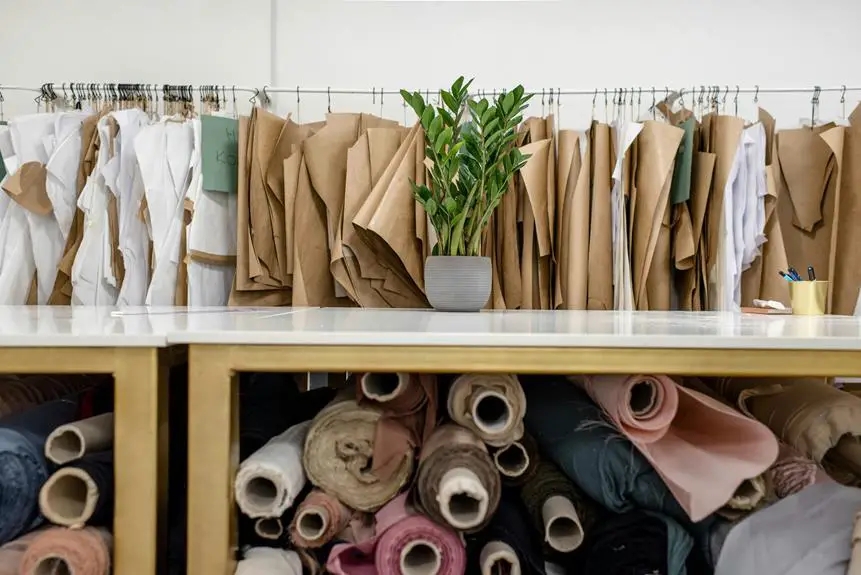You're likely aware that Jacquard weaving has a rich history, but its future in the textile industry is where things get intriguing. With technological advancements on the horizon, you might find yourself questioning how innovations like AI and smart fabrics will redefine production and design. As consumer preferences shift towards sustainability and unique textiles, Jacquard could play a pivotal role in this transformation. What remains to be seen is how these changes will impact both the creative landscape and the market as a whole.
Table of Contents
Historical Background of Jacquard
Exploring the origins of the Jacquard loom reveals a revolutionary shift in textile production during the early 19th century. You'll find that Joseph Marie Jacquard, a French weaver, invented this remarkable device in 1804. His invention allowed for the automatic control of weaving patterns through a series of punched cards. This innovation transformed the industry, enabling workers to produce intricate designs much faster than before.
Before the Jacquard loom, weaving was a labor-intensive process, requiring skilled artisans to manipulate threads by hand. The introduction of this loom not only improved efficiency but also democratized the production of complex fabrics, making them accessible to a broader audience.
You might notice that the Jacquard loom's design inspired future technologies, laying the groundwork for computer programming and automation. As you delve deeper into the history, you'll see how the Jacquard loom played a crucial role in the Industrial Revolution, marking a shift from manual labor to mechanization.
This evolution in textile production didn't just enhance productivity; it also altered societal structures, influencing everything from fashion to labor practices. Understanding this background enriches your appreciation of the textile industry today.
Technological Advancements in Jacquard
The Jacquard loom's evolution has paved the way for numerous technological advancements, significantly enhancing the efficiency and creativity of textile production.
One major development is the integration of computer-aided design (CAD) software, which allows you to create intricate patterns with ease. This software streamlines the design process, enabling you to visualize and modify your ideas before they reach the loom.
Moreover, modern Jacquard looms now incorporate advanced sensors and automation, improving precision and reducing manual intervention. These innovations let you produce complex designs at a faster pace, minimizing errors and waste. By utilizing these technologies, you'll find it easier to experiment with various materials and textures, pushing the boundaries of your creativity.
Additionally, advancements in yarn technology, such as the use of specialty fibers, allow for even more dynamic and vibrant textile creations. With these developments, you can create richer designs that stand out in the competitive textile market.
As you embrace these technological advancements, you'll discover new avenues for artistic expression and operational efficiency, ensuring the Jacquard loom remains a vital part of the textile industry's future.
Digital Weaving Techniques
In exploring digital weaving techniques, you'll discover how innovative technologies are reshaping the textile landscape.
These advancements not only promote sustainable fabric production but also offer enhanced design flexibility.
Let's take a closer look at how these elements are transforming the industry.
Innovative Weaving Technologies
Digital weaving techniques revolutionize the textile industry by allowing for intricate patterns and designs to be easily created and customized.
With the integration of advanced software and machinery, you can manipulate various threads and colors in real-time, resulting in stunning fabrics that meet specific demands. This technology enables you to produce small runs of unique designs without the extensive setup costs typically associated with traditional weaving methods.
You'll find that digital weaving not only enhances creativity but also increases efficiency. By using digital files, you can streamline the production process, reducing lead times significantly. This means you can quickly respond to market trends and consumer preferences, giving you a competitive edge.
Moreover, innovative weaving technologies can accommodate a broader range of materials, allowing you to experiment with blends that might've been impractical before. As a result, you can create fabrics that aren't only visually appealing but also functional.
Whether you're working on fashion, upholstery, or industrial applications, digital weaving techniques transform your vision into reality, making it easier than ever to innovate in the textile industry.
Sustainable Fabric Production
With the rise of innovative weaving technologies, sustainable fabric production has become more achievable, allowing you to create eco-friendly textiles without sacrificing quality or design. Digital weaving techniques, like Jacquard, have revolutionized the textile industry by minimizing waste and using resources more efficiently. These methods enable you to produce intricate designs while utilizing fewer materials, resulting in a smaller environmental footprint.
Here's a quick overview of the benefits of sustainable fabric production using digital weaving techniques:
| Aspect | Benefits |
|---|---|
| Material Efficiency | Reduces fabric waste |
| Energy Consumption | Lowers energy usage |
| Design Versatility | Allows for intricate patterns |
| Resource Management | Utilizes sustainable fibers |
| Economic Impact | Decreases production costs |
Enhanced Design Flexibility
Embracing advanced weaving techniques like Jacquard empowers designers to create complex patterns and textures that were once unimaginable.
With digital weaving, you have the ability to customize designs at an unprecedented level. You can manipulate colors, shapes, and styles with a few clicks, making it easy to experiment and innovate.
This flexibility allows you to respond quickly to market trends and customer preferences. If you see a certain style gaining popularity, you can adapt your designs almost instantly, ensuring you stay ahead of the curve. Plus, you can easily scale your designs from small to large quantities without compromising quality.
Digital weaving also opens the door to integrating various materials, combining traditional and modern textiles seamlessly. This not only enhances the aesthetic appeal but also provides unique functional benefits, like improved durability or comfort.
Sustainable Practices in Jacquard
When you think about sustainable practices in Jacquard, consider how eco-friendly materials can make a significant difference.
You'll also want to explore waste reduction techniques that not only preserve resources but enhance the overall efficiency of production.
Together, these approaches can lead to a more responsible textile industry.
Eco-friendly Materials Utilization
Many textile manufacturers are increasingly adopting eco-friendly materials in Jacquard weaving to minimize environmental impact and promote sustainability.
By choosing sustainable fibers, you not only contribute to a healthier planet but also enhance the appeal of your products to eco-conscious consumers.
Here are some popular eco-friendly materials being utilized in Jacquard weaving:
- Organic Cotton: Grown without synthetic fertilizers or pesticides, it's a healthier choice for both the environment and the farmers.
- Tencel (Lyocell): Made from sustainably sourced wood pulp, Tencel is biodegradable and produced in a closed-loop process to minimize waste.
- Hemp: A fast-growing plant that requires little water and no pesticides, making it an excellent sustainable option.
- Recycled Polyester: Created from post-consumer plastic bottles, it reduces waste and energy consumption by repurposing materials.
Waste Reduction Techniques
Implementing waste reduction techniques in Jacquard weaving can significantly enhance sustainability while optimizing resource use.
One effective method is to minimize fabric waste during the cutting process. By using digital design tools, you can create patterns that maximize fabric usage, reducing off-cuts and leftover material.
Another technique involves recycling leftover threads and fabrics. Instead of discarding these materials, consider repurposing them into new products or donating them to organizations that specialize in upcycling. This not only reduces waste but also fosters creative innovation within your designs.
Additionally, you can adopt a just-in-time production approach. By producing only what's needed, you can prevent overproduction and the associated waste. This strategy requires accurate forecasting and strong communication with suppliers, but it can save resources and improve efficiency.
Creative Applications in Design
Jacquard technology transforms textile design by allowing artists to create intricate patterns and textures that were once impossible to achieve. You can push the boundaries of creativity, making textiles not just functional but also a canvas for artistic expression. This technology opens up a world of possibilities for your designs, enabling you to explore new aesthetics and innovative techniques.
Here are some creative applications you might consider:
- Customizable Fabrics: Design unique pieces for fashion or interior decor, tailoring patterns to individual preferences.
- Interactive Textiles: Combine Jacquard with smart technology to create fabrics that change color or pattern based on user interaction.
- Artistic Collaborations: Work with artists to translate their artwork into fabric designs, bringing fine art into everyday textiles.
- Architectural Textiles: Use Jacquard to produce striking wall coverings or curtains that enhance the visual appeal of spaces.
Market Trends and Consumer Demand
Current consumer demand for unique and personalized textiles is driving innovative uses of Jacquard technology in the market. You're likely noticing that more brands are tapping into Jacquard weaving to create custom designs that resonate with individual tastes. This shift isn't just about aesthetics; it's about creating emotional connections with consumers who crave authenticity in the products they buy.
You may also see a rise in sustainable practices as brands integrate eco-friendly materials into their Jacquard textiles. Consumers are increasingly seeking out products that reflect their values, and brands are responding accordingly. They're adopting Jacquard technology not just for its ability to produce intricate patterns but for its potential to minimize waste and enhance durability.
Additionally, the focus on limited editions and exclusive collections is becoming more prominent. You might find that Jacquard textiles are being marketed as luxury items, appealing to a demographic that values craftsmanship and individuality. This trend highlights how Jacquard technology isn't only meeting demand but anticipating it, shaping the future of textile design.
As you explore the market, keep an eye on how these trends evolve and influence your choices in textiles.
Future Prospects and Innovations
The future of textiles is bright as innovations in Jacquard technology promise to redefine design possibilities and enhance sustainability. You're likely to witness a wave of advancements that won't only improve functionality but also change how you perceive textile design.
Here are some exciting prospects you can expect:
- Smart Fabrics: Imagine textiles that adjust to temperature or moisture levels, enhancing comfort and functionality.
- Sustainable Materials: Innovations will focus on biodegradable or recycled fibers, reducing environmental impact.
- Customized Design: With advanced Jacquard machines, you'll be able to create unique patterns tailored to individual tastes quickly.
- Integration with Technology: Expect textiles that interact with smart devices, opening new avenues in fashion and home decor.
These innovations not only promise to elevate aesthetics but also align with global sustainability goals. As a consumer, you'll have more choices and opportunities to engage with textiles that reflect your values and lifestyle.
The Jacquard technology evolution is set to transform your experience in the textile industry.
Frequently Asked Questions
What Is the Origin of the Jacquard Loom's Name?
The jacquard loom's name comes from Joseph Marie Jacquard, who invented it in 1804. His innovative design revolutionized weaving by using punched cards to control patterns, greatly influencing textile production and design techniques.
How Does Jacquard Technology Compare to Traditional Weaving Methods?
Jacquard technology revolutionizes weaving by using programmable patterns, allowing for intricate designs with less manual effort. In contrast, traditional methods rely heavily on handwork, making them slower and less versatile in design capabilities.
Can Jacquard Be Used for Non-Textile Applications?
Yes, you can use Jacquard technology for non-textile applications. It's applicable in fields like graphic design, architecture, and even product design, where intricate patterns and customizable features enhance functionality and aesthetics beyond traditional textiles.
What Impact Does Jacquard Have on Job Markets in Textiles?
Jacquard technology's impact on job markets in textiles can be significant. It often streamlines production, reducing manual labor needs. However, it also creates demand for skilled workers who can operate and maintain advanced machinery effectively.
Are There Any Notable Brands Specializing in Jacquard Fabrics?
When exploring jacquard fabrics, you'll find notable brands like Missoni, Etro, and Valentino. These designers use intricate patterns and textures, showcasing jacquard's versatility and elegance in high-fashion collections that captivate and inspire.
- How Does Ring Spun Cotton Affect Garment Fit and Shape Retention? - August 13, 2024
- What Are the Challenges in Producing Ring Spun Cotton? - August 13, 2024
- Is Ring Spun Cotton Suitable for Plus-Size Clothing? - August 13, 2024




